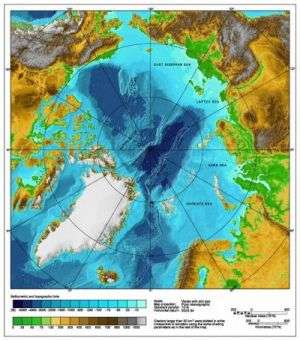Rocks under the northern ocean are found to resemble ones far south

Scientists probing volcanic rocks from deep under the frozen surface of the Arctic Ocean have discovered a special geochemical signature until now found only in the southern hemisphere. The rocks were dredged from the remote Gakkel Ridge, which lies under 3,000 to 5,000 meters of water; it is Earth’s most northerly undersea spreading ridge. The study appears in the May 1 issue of the leading science journal Nature.
The Gakkel extends some 1,800 kilometers beneath the Arctic ice between Greenland and Siberia. Heavy ice cover prevented scientists from getting at it until the 2001 Arctic Mid-Ocean Ridge Expedition, in which U.S and German ice breakers cooperated. This produced data showing that the ridge is divided into robust eastern and western volcanic zones, separated by an anomalously deep segment. That abrupt boundary contains exposed unmelted rock from earth’s mantle, the layer that underlies the planet’s hardened outer shell, or lithosphere.
By studying chemical trace elements and isotope ratios of the elements lead, neodymium, and strontium, the paper’s authors showed that the eastern lavas, closer to Siberia, display a typical northern hemisphere makeup. However, the western lavas, closer to Greenland, show an isotopic signature called the Dupal anomaly. The Dupal anomaly, whose origin is intensely debated, is found in the southern Indian and Atlantic oceans, but until now was not known from spreading ridges of the northern hemisphere. Lead author Steven Goldstein, a geochemist at Columbia University’s Lamont-Doherty Earth Observatory (LDEO), said that this did not suggest the rocks came from the south. Rather, he said, they might have formed in similar ways. “It implies that the processes at work in the Indian Ocean might have an analog here,” said Goldstein. Possible origins debated in the south include upwelling of material from the deep earth near the core, or shallow contamination of southern hemispheric mantle with certain elements during subduction along the edges of the ancient supercontinent of Pangea.
At least in the Arctic, the scientists say they know what happened. Some 53 million years ago, what are now Eurasia and Greenland began separating, with the Gakkel as the spreading axis. Part of Eurasia’s “keel”—a relatively stable layer of mantle pasted under the rigid continent and enriched in certain elements that are also enriched in the continental crust—got peeled away. As the spreading continued, the keel material got mixed with “normal” mantle that was depleted in these same elements. This formed a mixture resembling the Dupal anomaly. The proof, said Goldstein, is that the chemistry of the western Gakkel lavas appear to be mixtures of “normal” mantle and lavas coming from volcanoes on the Norwegian/Russian island of Spitsbergen. Although Spitsbergen is an island, it is attached to the Eurasian continent, and its volcanoes are fueled by melted keel material.
“This is unlikely to put an end to the debate about the origin of the southern hemisphere Dupal signature, as there may be other viable explanations for it,” said Goldstein. “On the other hand, this study nails it in the Arctic. Moreover, it delineates an important process within Earth’s system, where material associated with the continental lithospheric keel is transported to the deeper convectiing mantle.”
Source: The Earth Institute at Columbia University




















